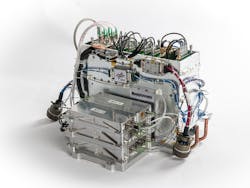Menlo Systems launches next-gen optical clock into space
On Sunday, May 13th 2018, Menlo Systems (Martinsried, Germany) launched its next-generation optical clock into space. The payload consisted of two separate units—a fully automated dual frequency comb system (FOKUS II) and an iodine stabilized laser (JOKARUS), together forming an optical clock. Iodine based optical clocks can achieve much better precision than previously used rubidium gas cells.
RELATED ARTICLE: FOKUS frequency comb launches into space again, compares three clock frequencies
On its 10 minute journey carried by a sounding rocket the scientific payload reached an altitude of 238 km and experienced 6 minutes of microgravity. The payload with the comb sustained vibrations up to 9 g rms, shocks of up to 21 g, and constant accelerations up to 12 g. Under these conditions, the fully automated comb system successfully performed its mission—and compared the iodine optical reference with a standard radio frequency atomic clock. The device remained operational over the full flight.
This is the third time that an optical clock from Menlo Systems has visited space, after previous flights in April 2015 and January 2016. Compared to the previous missions, the system was re-engineered for largely reduced size and power intake. Although much more compact, the system consists now of two independent comb units, offering experimental flexibility and redundancy.
Laser optics were redesigned from scratch and were built with low outgassing materials. Furthermore, the system is qualified for operation under vacuum. Despite its small size and low power intake, the performance of the combs is comparable to the latest commercial systems of Menlo Systems.
The optical reference, internally called JOKARUS, has been developed as a separate module in close collaboration between Humboldt University and the Ferdinand-Braun Institute in Berlin, the University Bremen, and Menlo Systems. The iodine reference has been characterized with both optical combs at the same time. Because the two combs were operated at slightly different repetition rates, the absolute frequency of the iodine reference can be unambiguously determined. The experiment represents the first dual comb measurement and comparison of two fundamentally different atomic and molecular references in space and under microgravity.
Future compact and reliable dual frequency comb systems in space can be game changers for precision spectroscopy, spectrometer calibration, sub-micrometer ranging, calibration of lidar lasers, and microwave generation in next-generation satellite missions. Based on the results of this flight, a long-term in-orbit verification of such devices is envisioned in the near future.
SOURCE: Menlo Systems; http://www.menlosystems.com/events/news-press-releases/view/2700
About the Author

Gail Overton
Senior Editor (2004-2020)
Gail has more than 30 years of engineering, marketing, product management, and editorial experience in the photonics and optical communications industry. Before joining the staff at Laser Focus World in 2004, she held many product management and product marketing roles in the fiber-optics industry, most notably at Hughes (El Segundo, CA), GTE Labs (Waltham, MA), Corning (Corning, NY), Photon Kinetics (Beaverton, OR), and Newport Corporation (Irvine, CA). During her marketing career, Gail published articles in WDM Solutions and Sensors magazine and traveled internationally to conduct product and sales training. Gail received her BS degree in physics, with an emphasis in optics, from San Diego State University in San Diego, CA in May 1986.
